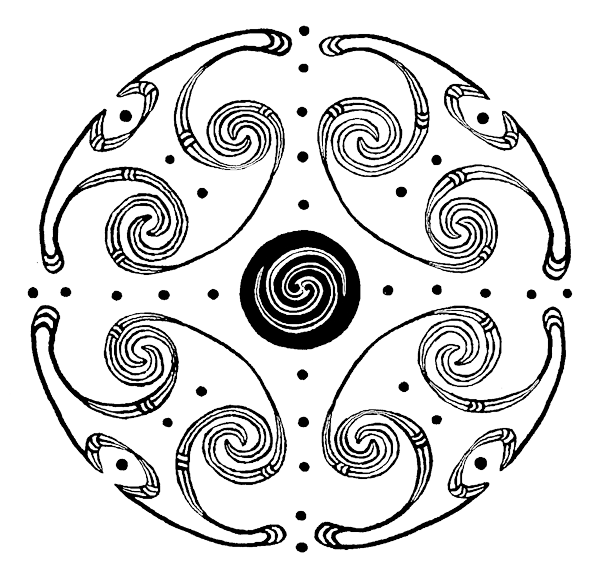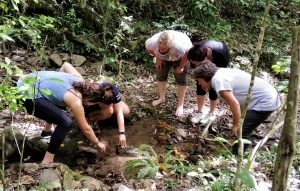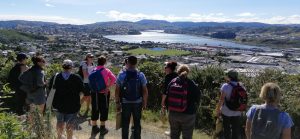
Urutengangana: Qualities of the first-born - guidance, safety, leadership.
“If we want children to truly flourish, to become truly empowered, let us allow them to love the earth before we ask them to save it” – Place-based educator, David Sobel.
Known improvements in well-being and education from connections with nature

Teachers connect with nature at Rangituhi.
Plenty of evidence points to reduced stress, greater physical health, more creativity and improved concentration for students who regularly spend time in natural settings.
Teachers are also in need of the improved well-being that comes from spending time in nature and they need to feel a connection with nature in order to pass it on to students.
Enviroschools and the Porirua Harbour Trust recognised that the professional development they had been providing for teachers in Porirua up until 2017 had involved lots of talk about taking students into the natural environment, yet the workshops were predominantly indoors.
Local Porirua educators try something new with ‘Nature is Our Classroom’
With a significant forest remnant right on the doorstep of Porirua schools, Rangituhi (referred to by some as Colonial Knob) provided the perfect location for teacher professional development in the outdoors.
In March of 2017, Amanda from Enviroschools and Rebecca from the Porirua Harbour Trust, with funding support from Greater Wellington Regional Council, gathered together their first group of teachers from schools in the wider Porirua catchment. The aim was to spend as much of the day as possible outside – slowing down, observing, connecting, sharing, being inspired and being curious.
“Ka oho te wairua, ka mataara te tinana, he aroha ki te aroha, ka kaa te rama” – Nā Te Rauparaha.
The ‘Nature is Our Classroom’ experience was highly valued by Porirua schools, and throughout 2018/19 two sessions per year have been held, some at Rangituhi and others at Pāuatahanui Wildlife Reserve and at Seton Nossiter Park.
Over time the programme has been fine-tuned and the model was shared at the 2018 New Zealand Association of Environmental Education Conference, inspiring teachers nationally.
Components of a successful teacher professional development day in nature

A catchment-wide view enables us to connect with a place in a whole new way.
Nature is Our Classroom days work best with a maximum of 15 participants at one time.
When teachers from across the spectrum of early childhood to secondary work together with others whose schools or centres are in close physical proximity, there is an added bonus of developing a sense of community and fostering opportunities for future connections between those schools and centres.

Ideas abound as teachers share their experiences with colleagues.
Key aspects of a successful programme include a slow enough pace to allow genuine engagement with nature, opportunities for a catchment-wide view and engaging with local environmental groups and mana whenua.
At times Porirua Harbour Trust has been able to offer some paid teacher release time and, when this is in short supply, the programme has been held during school holidays and has still been well attended.
Many schools have taken the opportunity to build the culture of their team by sending more than one teacher and members of management. While open to all schools the programme has been particularly popular with schools and centres that are part of the Enviroschools network.
This model has successfully helped teachers see the value of using unstructured outdoor time with their students on a daily basis.
“Taking what is around us can be used powerfully to enhance the New Zealand Curriculum. I learned how easy it is to integrate the environment throughout a learning programme” – Teacher.
Changes taking place in Porirua schools

The kids at Discovery School are loving it!
Participants have been putting their learning into practice and taking their students outside as part of their regular programmes and they say this is really improving their students’ engagement in learning.
Junior and senior classes at Discovery School buddied up and spent the day in their local bush on Spinnaker Mountain.
Corinna School offers a range of one hour nature explorations as an option in their weekly play-based learning sessions. Students collected seed from their local bush to make seed balls and held a seedball throwing event on World Environment Day in 2018.
Teachers from Paremata School organised trips for students to Rangituhi and Ngāti Toa School say the professional development has provided a catalyst for a host of education outside the classroom opportunities across the full range of curriculum areas:
• mathematics learning outside – making shapes with different natural materials & art work linked to geometry, measuring the age of trees,
• bush and beach explorations (including crab hunting),
• tree planting in the community and at school,
• development of a spare parts play area for students,
• stream restoration, eel hunting and fishing, and
• writing outside.

Ngāti Toa school education outside the classroom.
The whole senior syndicate engaged in a two day programme at Camp Elsdon. This included natural art, camp cooking, walks to Rangituhi, flora and fauna studies, group games, and learning Māori history and legends. Reading, writing and maths integrated with the different activities.
Teachers say children are loving doing their learning in the wider community and the natural environment.
The positive stories just keep coming and the ‘Nature is our Classroom’ professional development has provided the impetus for schools to engage with sustainability education more broadly, with some schools beginning discussions about becoming an Enviroschool.
